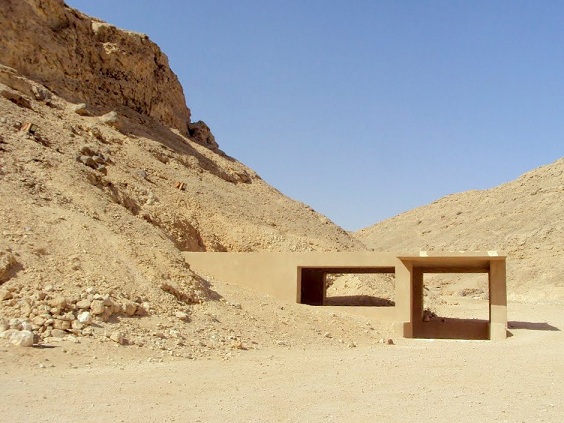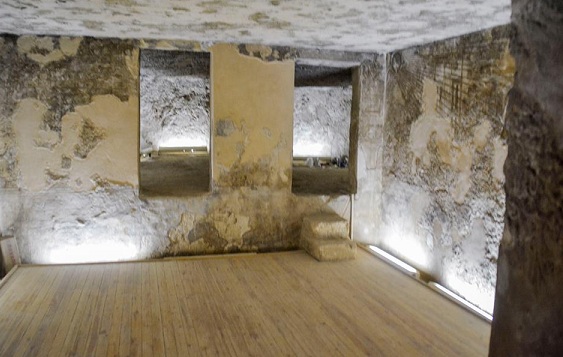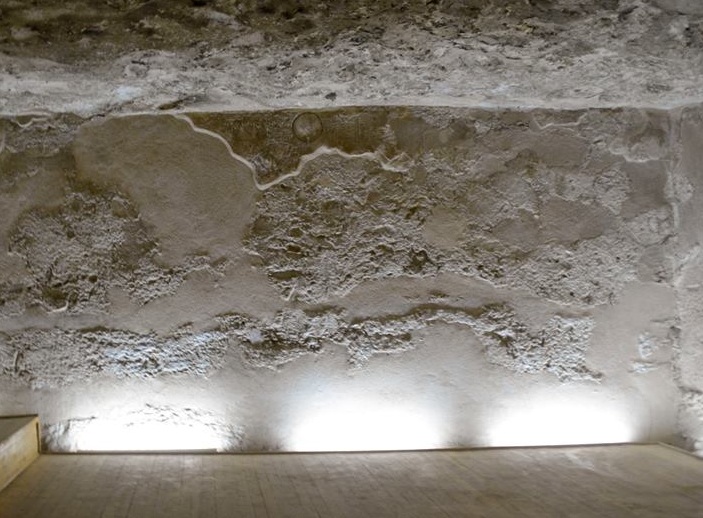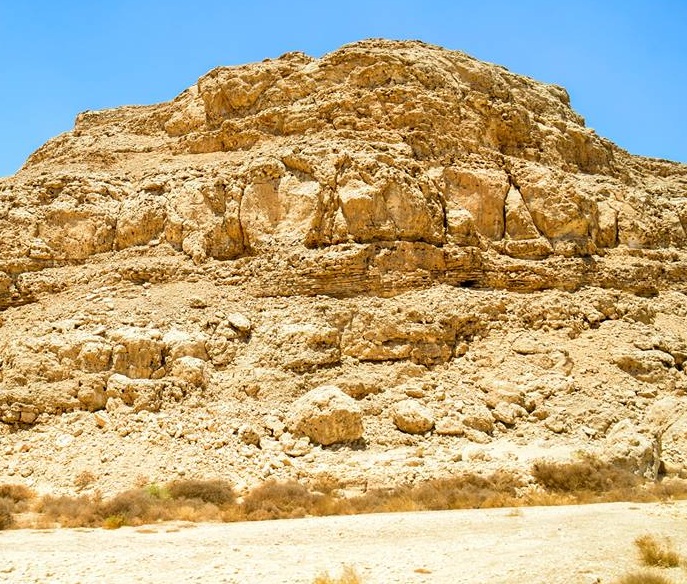The Royal Tomb of Akhenaton

The Royal Tomb of Akhenaton is located six kilometers up the Royal Wadi (in Amarna) which separates the hills surrounding Akhetaton from the east and thus separating the northern private tomb from the southern ones.
Plan of the Royal Tomb of Akhenaton
The interior plan of the Royal Tomb of Akhenaton consists of numerous parts including:
The tomb's entrance leads to a stairway of 20 steps with a central slide of about one meter in width. The side walls of the stairway were originally covered by a layer of plaster, many parts of which have disappeared nowadays.
• The staircase leads to a long sliding corridor that lacks decoration inclining at an angle of 16 degrees. The corridor was once covered by a layer of plaster, few traces of which can still be seen.
• Halfway in the right side of the corridor, there opens a doorway that leads to 6 unfinished corridors and chambers. Opposite the doorway to these chambers is another rectangular opening probably intended for making one or more rooms; but was never finished.
• There is a sliding staircase of about 18 steps with a central slide of 1 meter in width. The staircase declines at an angle of 40 degrees. The side walls also lack decoration but they were once covered by a layer of plaster.
• At the top of this staircase, to the right, a doorway opens and leads to three decorated rooms known as Alpha, Beta and Gamma.
• On the wall, opposite to this doorway, another rectangular opening was made for making another room or a series of rooms; but works were abandoned there.
• At the foot of the staircase, lies a doorway that leads to the well shaft (about 3.12 m deep). The walls of the room that form the upper part of the well were once decorated by scenes (now all disappeared) of the royal couple making offerings to Aten. The function of the well is to protect the tomb from floods and severe storms.
• The well room directly leads to the door of the burial chamber of the King. The entrance to this chamber was blocked by 6 stones arranged horizontally and 2 vertically. The same type of these blocks was found inside the well, which implies that the burial chamber was opened.
• The burial chamber is squared in shape. The floor of the southern side of the chamber is slightly raised about 35 cm. The roof of this area is supported by two pillars. The walls and ceiling of this chamber were once coated by a layer of plaster and then painted. However, only few scenes can still be seen.
• The area behind the pillars was used in storing funerary equipments.
• In the middle of the floor area lies the base of the sarcophagus of the King.
• At the corner of the right wall of the burial chamber another chamber was cut but abandoned.
Decoration of the Burial Chamber of the Royal Tomb of Akhenaton

The burial chamber of Akhnaton Royal Tomb is regarded as the largest, and the most decorated in the entire tomb. The walls, ceiling and piers of Akhnaton Tomb were all decorated by colorful scenes. However, these scenes were destroyed by the followers of Amun seeking revenge from Akhenaton. Only scenes high on the walls remained as the destroyers couldn’t reach them. Still, from these remains, scholars were able to put together some of the scenes that must have occupied these walls.
• Among these scenes is a scene depicting the King and the Queen followed by four of their daughters, in front of heaped offering tables as they are making offerings to Aten, under the god's rays. Behind them, the wall is divided into 4 registers showing rows of attendants.
• Another scene represents the King, Queen and her daughters, all under the rays of Aten, mourning the death of a female figure to the right represented under a canopied shrine decorated by a frieze of cobras. Scholars believe that the figure was that of Queen Tiye. The scene also contains mourners in different Attitudes.
• On a third wall, depicted an adoration scene showing 5 representations of Aten, the biggest is shown above the royal couple who are shown adoring the sun disc.
• Another scene on the northern wall, just opposite to the base of the sarcophagus, shows the royal family mourning a figure of an unknown deceased placed under a canopy which is in turn surmounted by a representation of Aten.
• As for the pillars, they were probably decorated by representations of the sun disc as well as by inscriptions giving epithets of Aten and names and titles of both the King and the Queen.
Decoration of the Rooms of the Royal Tomb of Akhenaton
The Royal Tomb of Akhenaton comprises mainly of three rooms: Alpha, Beta and Gamma. The three rooms were cut during the 12th regnal year of Akhenaton, after the death of Meketaton. They lead to one another. The walls of Alpha and Gamma are decorated while those of Beta lack decoration either because it was used as a storing room for the other rooms or because it was never finished.
Alpha Room in the Tomb of Akhenaton

The Alpha room in Akhenaton Tomb measures 5.5km² with a height of 3 m. Both the walls and ceiling were coated by a layer of plaster then painted by colorful scenes. Gracefully, the room contains four niches (which implies that it was a burial chamber) on the northern, southern, eastern and western walls, cut after the walls were completely decorated. They were meant for housing amulets and magical bricks inscribed by chapter 151 of the Book of the Dead. After they were filled with their contents, they were sealed with plaster. Yet, unfortunately, the contents of these niches were stolen.
• Both the western and eastern walls are similarly decorated but on the latter, the sun is rising while on the former it is setting. Both walls show the royal couple followed by two of their daughters, all under the rays of Aten. They are performing the morning rituals in front of the sanctuary of the Great Temple. Behind the royal couple, the scene is divided into registers showing fan bearers courtiers and charioteers, all in front of the gates of the palace.
• The northern wall is a continuation of the scene on the eastern one as all the figures on this wall face the direction of the rising sun. The wall is divided into 7 registers. The first 4 represent the military and civil population of Akhetaton in different postures. As for the other 3, they represent Nubians and Asiatics adoring Aten.
• The southern wall represents a scene of two episodes showing the royal family mourning the death of Meketaton. The first episode represents the royal couple in one of the palace's rooms leaning forward in a mourning attitude, under the rays of Aten. Outside the room, female mourners are represented while weeping. The second episode represents the couple in the same attitude but in front of the deceased body lying on a funerary bed.
Gamma Room of the Royal Tomb of Akhenaton

The Gamma room is the second major room within Akhenaton Royal Tomb that measures 3.5 X 2m in height. Both its walls and ceiling were once coated with plaster. It is probable that it had been the burial chamber of Meketaton. The scenes on the room's walls are in a bad condition. However, in a scene similar to the scene on the southern wall of Alpha, the royal couple is represented in front of the funerary bed of Meketaton.
• On the opposite wall, another scene represents a figure of Meketaton under a canopy decorated by a cavetto cornice. In front of the canopy, the royal couple is shown leaning in a mourning attitude under the rays of Aten. Behind the couple, there are three of the deceased's sisters, all with signs of grief. The rest of the scene shows female mourners in different attitudes.




